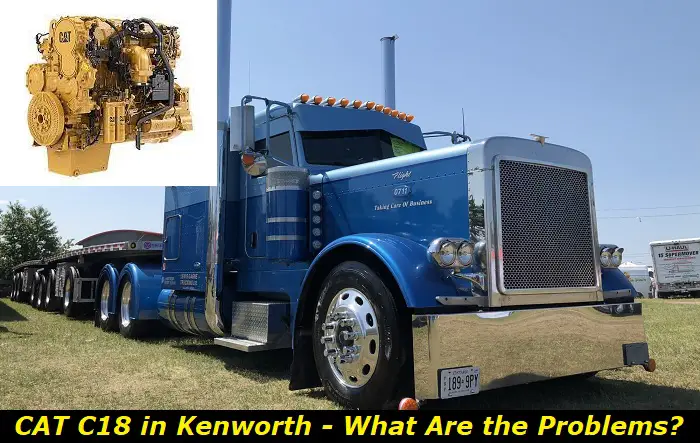C18 CAT Engine in Kenworth: Problems, Durability, and Specs
CAT engines are famous for their durability, reliability, and wide application across many platforms. They are to be found in trucks, industrial engines, agricultural machinery, tractors, cranes, aircraft, irrigation equipment, water vessels, and pumps among many other uses. The CAT engine first appeared in 1910 when the Holt Manufacturing Company patented the Caterpillar trademark on its first tractor model. Since then, the CAT brand has grown to become one of the best-known globally.

The CAT engines used in trucks and tractors come in a wide range of series and configurations. The engine models include, but are not limited to the C series (1.1 through to 6.6, and then C9, C11, C13, C15, and C18). These are diesel engines that are mainly used in trucks and other heavy machinery.
The C18 engine is manufactured with a design that can be configured or customized to meet different applications by the operator. This article will provide an insight into the specs, problems, and durability of the C18 diesel engine that is used in the Kenworth truck and other applications.
The C18 is an in-line, 6-cylinder 4-stroke engine with an electric control unit and a direct injection MEUI fuel system. The turbocharged engine uses an air-to-air engine after-cooling system producing between 700 and 1130 HP at 1500 RPM. The engine is equipped with ACERT (Advanced Combustion Emissions Reduction Technology) to meet the EPA and Euro emissions standards protocols and an ADEM (Advanced Digital Engine Management) control system.
The ACERT system covers four critical engine/vehicle systems to reduce the toxicity of the exhaust gases. The four sections covered by the ACERT system include:
- The fuel combustion stage
- Air intake system
- Fuel system
- An electronically controlled system to manage the combustion/exhaust system
This C18 ACERT engine package presents the following advantages to the user-
- It has a tight manufacturing tolerance that gives superior performances
- The Monotherm pistons are fitted with narrow rings that improve compression efficiency
- The crankcase is strong and secure due to its modern design
- The MEUI fuel system is economical and reliable throughout the engine's life
On the other hand, the ADEM system enables an electronic engine control for all its critical functions relating to:
- Variable ignition and timing
- Speed control
- Engine protection
- Shutdown controls
- Updated diagnostics
- Improved user interface and automation
The Caterpillar diesel C18 engine is designed for use by road-going vehicles which are up to 65 tonnes in weight. Among the trucks that have adopted the C18 diesel engine is the Kenworth T800.
The Kenworth Truck
Kenworth was the first American truck manufacturer to use diesel engines as standard in their trucks. The Kenworth T800 is a workhorse truck providing long and short-haulage deliveries in many States. The Kenworth T800, apart from having the C18 engine, comes with the following specs:
- A single base chassis that is flexible for many applications
- It has a high-hood model
- It comes with a manual transmission
- It has a large 1, 430 square inches radiator for efficient cooling
- It has an integrated large sleeper cab
The CAT C18 Specs
The C18 is an EPA Tier IV-compliant diesel engine. The engine has a length of 55.7 inches, 49.5 inches in height, and a width of 38.5 inches. It weighs approximately 3688 pounds, giving out 2696 lb-ft torque at 1400 RPM. The C18 was designed for tough jobs and is ideal for the Kenworth truck.
Key Specs
Maximum torque 2736 lb-ft at 1300 pm
Maximum power 800hp or 560KW
Engine Dimensions:
- Length 56.6 inches (1, 437.6 mm)
- Width 44.6 inches (1, 132.8 mm)
- Height 53.4 inches (1, 356.4 mm)
- Weight (Net Dry) 1, 673 kg (3, 688.3 lbs)
- Maximum Torque 2, 736 lb-ft (at 1,300 RPM)
- Engine In-Line 6 4-Stroke
- Combustion Direct Injection
- Firing Order 1-5-3-6-2-4
- Displacement 1104 Cubic Inches (18.1 liters)
- Cylinder Bore 5.7 inches (145 mm)
- Cylinder Stroke 7.2 Inches 183 mm)
- Aspiration Turbo Charged with air cooling configurations (TA or TTA)
- Compression Ratio 16.3:1
- Water Pump Centrifugal
- Cooling System 2 circuit system equipped with additional air-cooling circuit
Other C18 specs
- The engine uses a single-can DOC (Diesel Oxide Catalyst) catalytic converter that is maintenance-free and does not require cumbersome thermal regeneration procedures since it uses a passive after-treatment technology
- The engine has 5,000-hour between services giving owners enough productive period for maximum benefits
- The engine does not use the Diesel Exhaust Fluid (DEF) system which enables the engine not to have any DEF-related components such as the DEF pump, electronics, tank, or lines. The absence of these components reduces the overall size of the engine.
- Power Density engine comes with a high power density that enables a reduction in the size of some devices such as motors.
- The engine design brings reliability, quiet operations, and a long lifespan
- The engine has low maintenance costs that match the optimized fluid consumption for the different operating cycles of the engine.
- The C18 engine has a compact and simplified after-treatment system that is easy to mount and access for maintenance.
- The engine has a low heat rejection level that enables optimized cooling that is equivalent to the engine power output.
- The C18, apart from meeting the EPA and Euro V emissions protocols, also incorporates non-road Emissions Standards
- It has a simplified design and installation process for all regions across the globe.
- The C18 comes with a fuel-efficient drivetrain, smart aerodynamics, great maneuverability, and a comfortable driving environment that keeps the operator at ease.
Problems
The CAT C18 engine has its downsides despite its reputation for reliability and efficiency. The following are some of the most common issues that affect the C18 engine
1) Cylinder Head Issues
Cylinder head-related problems usually arise depending on how the engine has been used and its maintenance routine. The cylinder head may suffer issues ranging from leakages to total failure. The most common issues are:
- Warping due to overheating
- Porous cylinder head due to manufacturer defects
- Cracked cylinder head
- Damaged cylinder head parts such as valves and seals
Cylinder head problems can arise from:
- Problems relating to the engine block design which affect the cylinder head functionality
- Weaknesses in the cylinder liners which tend to shrink or crack over time due to their position
- Blown-out rings due to weak cylinders
- Leaking or faulty head gasket
- Leaking spacer plate which allows oil to seep through
Cylinder head problems affect the entire engine since the combustion and compression processes all take place in the cylinder head. The intake and exhaust systems are also affected by cylinder head issues and the entire engine is compromised and may become useless.
Signs that your cylinder head has issues include:
- Coolant leaking into the engine oil
- Loss of coolant
- Loss of coolant- the coolant system is sealed and a faulty cylinder head could allow coolant to leak through.
- The presence of fluids in the exhaust system-coolant, oil, or any other fluid in the exhaust is a sign of a damaged cylinder head.
- Loss of compression
- Smoky exhaust
- The presence of sludge below the oil cap
- Engine overheating
- Reduced engine performance
2) Turbocharger Issues
A turbocharger works in sync with all other engine systems such as the air, cooling, and exhaust systems. The turbocharger should perform optimally to provide the engine power boost. Issues relating to the turbocharger will affect engine performance, hence reducing the efficiency of the Kenworth truck.
The most common C18 turbocharger issues include:
- Turbo housing failure-housing may get damaged due to vibrations emanating from the exhaust system.
- Failed turbocharger bearings which cause a lot of friction between the moving parts leading to heat generation and wearing
- Failed turbo crossover pipes as a result of insufficient high-speed tolerance
- Carbon and other exhaust debris from the engine may clog or damage the turbo fins
- Oil contamination or starvation in the turbocharger due to clogging or leakages in the pipes
- Poor driving habits such as excessive idling, excessive revving, hard acceleration with a cold engine, or a sudden hot engine shutdown.
A damaged turbocharger may be indicated by:
- Low engine power
- Very low engine boost from the turbo
- Engine becoming very hot
- Oil consumption
3) Engine Failing to Start
Occasionally, the C18 may experience persistent hard starts or engine stalls after starting. This could be caused by:
- Dead/faulty/drained battery
- Faulty starter motor
- Faulty or poor electrical wire connections
- Clogged fuel/air intake/injectors
These issues compromise the engine starting process by reducing the critical ingredients needed for the cranking.
4) ACERT system failure
The ACERT control system is prone to causing problems to the C18 engine. The most persistent issues relating to the ACERT system include:
- Incomplete or failed regenerations
- Clogged injector heads
- Malfunctioning system sensors that return persistent error codes
- Fuel line issues
The ACERT system is supposed to control emissions and manage the exhaust system. When it has issues, it affects engine performance and may also lead to violation of the emissions protocols by the operators.
5) Failed Engine Electronics Controls
The C18 was designed for electronically controlled operations where the ECU monitors all engine responses to the operator inputs and environmental conditions including
- Engine speed
- Torque control
- Air-fuel ratio mixing and injection
- After-treatment
These responses determine how the ECM controls fuel injections. When this system has issues, the engine fuel injection system is affected leading to reduced efficiency and reliability.
Electronic control failures can arise from faulty computer onboard chips, faulty electric cables, liquids leaking onto electronic boards, or a faulty ECM.

Add comment